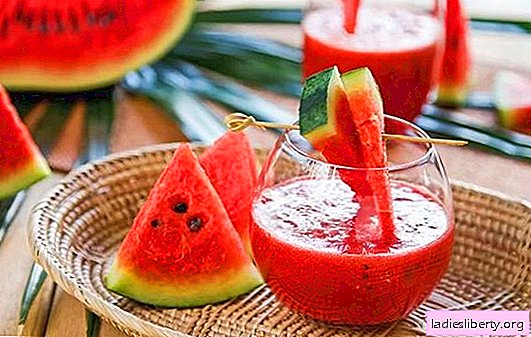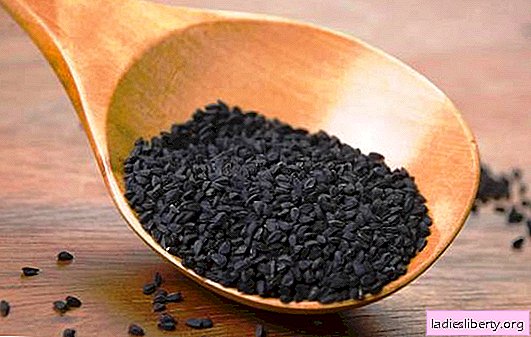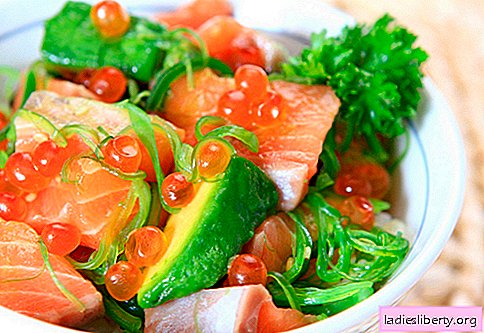
Watermelons belong to berries, which are useful in a high content of vitamins and minerals, at the same time - to products that are consumed in large quantities during the season and most often cause food poisoning. A high-quality watermelon is absolutely safe for health. Poisoning occurs due to improper cultivation and storage.
99% watermelon consists of water. During its ripening, it absorbs all substances in the soil, including a large amount of nitrates and pesticides.
The beneficial effects of quality watermelon on the body
The health benefits of a quality watermelon are undeniable:
• normalizes water-salt metabolism, removes toxins and toxins from the body;
• contains a large amount of vitamins (groups B, C), potassium and magnesium;
• has a low calorie content, therefore it is ideal for many diets, including long-term ones;
• a large amount of fiber and pectin improves the function of the digestive tract, urinary system;
• useful for anemia, atherosclerosis and other pathologies of the cardiovascular system, for urolithiasis, during pregnancy and in the postoperative period, to restore intestinal microflora;
• helps to increase immunity in environmentally unfavorable conditions.
Watermelon Poisoning - Causes
The cause of watermelon poisoning can be:
• a large number of nitrates contained in it - nitrogenous substances used to accelerate ripening, increase size and improve palatability;
• improper storage;
• getting into a watermelon pathogenic microorganisms that cause intestinal infection.
The most common cause of watermelon poisoning is nitrate poisoning. Nitrates are salts of nitric acid. They are normal in all melons: they are a source of nitrogen, which is necessary for all green plants for the photosynthesis process and is responsible for their growth and development. To avoid nitrogen deficiency, the soil is artificially saturated with mineral fertilizers that contain it (nitrate). As a result of nitrification in excess of the permissible concentration, nitrogen accumulates in watermelons. According to WHO, the permissible dose of nitrates is 3.7 mg / kg, and nitrite is 0.2 mg / kg. A sanitary and epidemic allowable daily allowance for an adult that is harmless to the body is 50 mg per 10 kg of body weight (0.5 g of nitrates can be taken without health consequences).
The permissible nitrate norm in the berry itself (watermelon) is 60 mg / kg, for grown in greenhouse conditions - 100 mg / kg.
In the clinical subtext, poisoning with nitrates and nitrites is considered, into which the former turn.
The mechanism of nitrate poisoning from watermelon
Need to know:
• fully ripened watermelon does not contain nitrates - they are processed into vegetable protein;
• lack of sunlight, a large amount of moisture, phosphorus and magnesium in the soil contribute to the absorption of nitrates;
• the maximum amount of nitrates is contained near the stem and under the skin;
• a slice of watermelon, oversaturated with nitrates, in water colors it in a bright color.
The nitrates themselves are low toxic. In the human body, they turn into toxic nitrites, the same process occurs in the watermelon itself with a high content of nitrates.
In case of poisoning with watermelon containing nitrates, the conversion of ferrous iron, which is contained in hemoglobin and carries oxygen, to ferric occurs in the blood. As a result, methemoglobin is formed, which cannot transport oxygen and leads to hemic hypoxia, the degree of which depends on the amount of methemoglobin in the blood. Oxygen starvation of body tissues develops. All tissues suffer from hypoxia, but especially the central nervous system and the cardiovascular system.
The level of methemoglobin in a healthy person is 0-3%.
The severity of watermelon poisoning and symptoms depend on the severity of methemoglobinemia:
1. At a level of 3 -15%, symptoms are not expressed, mild acrocyanosis is possible.
2. With watermelon poisoning, symptoms appear when 15% methemoglobin is formed in the blood. This is a mild degree (there is weakness, weakness, headache, dizziness, which are rarely given importance).
3. The formation of 15 to 40% methemoglobin in the blood causes a severe degree of poisoning.
4. More than 40% is very difficult. With 50% methemoglobin in the blood, death from suffocation is possible. Usually this corresponds to 8-14 g of nitrates or 1-4 g of nitrites.
Watermelon Poisoning - Symptoms
With watermelon poisoning, symptoms appear 2-4 hours after nitrates enter the body. It can be a clinic of acute gastroenteritis, or resemble toxic pneumonia, acute damage to the cardiovascular or nervous system. The severity of the condition depends on:
• doses of nitrates obtained;
• state of intestinal microflora, performing a protective function;
• individual sensitivity.
Symptoms of watermelon poisoning are:
• nausea, vomiting (sometimes "coffee grounds" - vomit is black, which indicates gastric bleeding);
• stomach ache;
• diarrhea (often black - melena), indicating gastrointestinal bleeding;
• pain in the right hypochondrium;
• ictericity (yellowness) of the sclera and skin;
• hyperhidrosis, severe weakness, headaches, dizziness;
• a sharp drop in blood pressure, palpitations;
• febrile temperature (above 380 C).
With a high nitrate content in watermelons, severe damage to the cardiovascular and nervous systems occurs:
• a sharp drop in blood pressure,
• tachycardia;
• acrocyanosis (cyanosis of the lips, tip of the nose, terminal phalanges of the fingers);
• cramps;
• shortness of breath;
• confused consciousness, sometimes loss of consciousness.
Pronounced acrocyanosis is explained by the high content of methemoglobin in the blood: it gives the blood a chocolate color.
When watermelon poisoning, symptoms in the form of an intense pulsating headache are associated with the expansion of the vessels of the brain under the influence of nitro compounds, which leads to:
• deep systemic hypotension (lowering blood pressure), tachycardia, acute cardiovascular failure, hyperhidrosis (relaxing and vasodilating effect of nitrites);
• decrease in platelet aggregation, in connection with which bleeding develops.
Emergency care and treatment of watermelon poisoning
In case of watermelon poisoning, treatment should be carried out in severe cases in a hospital setting. Before the arrival of an ambulance or a doctor, it is necessary to begin providing first aid.
In case of watermelon poisoning, treatment at home consists of the following measures:
• elimination of toxins (detoxification);
• detoxification;
• replenishment of the normal volume of circulating fluid after dehydration;
• correction of hypoxia;
• restoration of hemoglobin.
For this purpose it is necessary:
• stimulate vomiting with a slightly salted weak solution of manganese (in case of impaired consciousness, vomiting cannot be caused due to the risk of getting into the respiratory tract and asphyxiation);
• gastric lavage with a large amount of liquid (starting from the age of 5, for children under 5 years old - not recommended);
• intake of enterosorbents (Polysorb, Enterosgel, Smecta, Atoxil, Sorbex, white coal, activated carbon);
• the use of special water-salt solutions (Regidron, Trisol, Reopoliglyukin) and a large amount of mineral water without gas in small portions, but often so as not to cause repeated vomiting;
• after cessation of nausea, you can drink sweet tea with lemon in small sips;
• make a cleansing enema.
Painkillers, antidiarrheal drugs are contraindicated. The former can lubricate the clinical picture, the latter inhibit the elimination of toxins. With severe abdominal pain, it is permissible to take antispasmodics (No-shpa, drotaverine).
During pregnancy, at any time during watermelon poisoning, treatment should be carried out by specialists because of the high risk of hypoxia in the fetus and thrombosis in the pregnant woman.
Watermelon Poisoning Prevention
To avoid watermelon poisoning, you must follow certain rules:
1. Do not buy early watermelons, as well as late autumn. Season of these berries: end of August - September.
2. Choose small in size - up to 8 kg.
3. Before buying, carefully check the integrity of the peel, do not incise for testing.
4. Before use, thoroughly wash the watermelon with cold water, and then rinse with boiling water.
5. Since nitrates are concentrated up to 3 cm from the crust, it is not recommended to gnaw the pulp completely.
6. Do not store cut watermelon in the refrigerator for more than a day.
The use of watermelon is strictly contraindicated for lactating women and children up to a year because of the immune system that has not formed in infants, the intestines, and a small amount of blood.
If you follow the above recommendations, you can avoid poisoning and maintain health.











